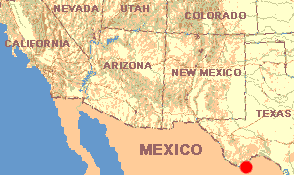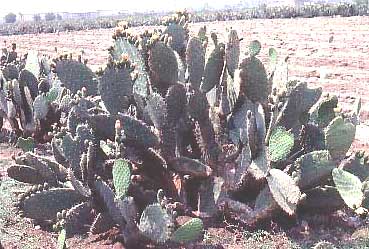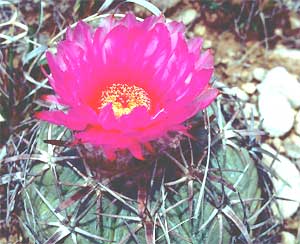 February 28, 1988
February 28, 1988TEXAS: Brewster County
K-Bar Campsite in Big Ben National Park; elevation about 3000 feet.
 February 28, 1988
February 28, 1988In the creosote-bush/ lechuguilla/ sotal/ clumpgrass flatlands around Henry at K-Bar, three species of pricklypear cactus are abundant; their names are:

As the above picture shows, pricklypears look like green, spiny, beaver tails stacked one atop the other, growing in sprawling clumps. Folks around Amistad lump together the Englemann and Brown-spined Pricklypears under the common name of nopal. However, both of these species have differentiated into several taxonomic varieties. Here I've often thought that I'd found what was for me a new species of pricklypear only to discover later that it was only variety of the Englemann or Brown-spined Pricklypear.
Especially on rocky slopes a remarkable non-prickly pricklypear appears -- one with no long spines! It's called the Blind pricklypear, Opuntia rufida. Mostly a Mexican species, it enters the U. S. only in Texas along the Rio Grande. This species takes its common name from the fact that despite its spineless condition it is abundantly equipped with tiny glochids. A superstition holds that wind carries these glochids into animals' eyes, blinding them.
Pricklypears belong to the genus Opuntia. As with most flowering plants, the species are defined mostly in terms of flower and fruit anatomy -- not characteristics of vegetative, or stem, parts. In the genus Opuntia this is especially apparent because many of its species, while bearing flowers and fruits typical of the genus Opuntia, possess stems that don't at all look like "stacked, spiny beaver tails."
One large group of non-flat-stemmed Opuntias is the cholla group, the members of which look like stacked, spiny cucumbers or pencils. Dog-Bill introduced us to the Christmas cholla, Opuntia leptocaulis. The same species grows here, though at Big Bend it is referred to as Tasajillo.
Another cholla found here is the Cane Cholla, Opuntia imbricata, growing six to eight feet tall.
Yet a third general class of Opuntia consists of several species looking like joined-together, very spiny, longish eggs lying on the ground. Usually these species' joints are so loosely attached to one another that if a trouser leg brushes against them entire joints come loose and stay stuck tothe cloth until they are knocked off. These disarticulated joints can root and form new plants, so their weak joint-connections constitute part of the plant's dispersal strategy. Often these species are not noticed until it's too late. The member of this group that I've found here fully deserves its name --the Devil Cactus, Opuntia schottii.
In review, at Big Bend I've seen seven species of the genus Opuntia-- four pricklypears, two chollas and one devil cactus.
The next-largest genus of cactus found during my walks here is Echinocereus, which usually is easy to recognize because its spines arise from atop ridges extending up and down the cylindrical cactus body, and sometimes spiraling around it. The most common Echinocerei found here are the:
You'll remember the Horse-crippler, the cactus at Amistad with only its amply spiny crown exposed at the ground's surface. That cactus, which I've not found here, is a member of our third big genus, Echinocactus. That genus is famous for it's heavy spines and roundish bodies. Echinocacti are known as barrel-cacti, and often grow quite large. The largest cactus seen so far is an Echinocactus.

The most common Echinocactus I've found here is the Eagle Claws Echinocactus horizonthalonius, shown at the right.
The Giant Fishhook, Echinocactus hamatacanthus, is a fairly rare species usually found on rock ledges. It's about two feet high and a foot thick, barrel-shaped, and bears reddish spines up to six inches long diabolically hooked at their tips. Just think of what happens to a deer poking its nose into a Giant Fishhook cactus, then trying to withdraw...
The last big genus is Mammillaria,which takes its name from the Latin word mamill,meaning breast or teat. Visualize this: A cluster of jalapeño peppers has its peppers' broad, round bottoms pointing outward so that the cluster looks something like a green, bumpy ball. Then attach clusters of radiating spines atop each of the exposed pepper-bottoms. Now you have a cactus of the genus Mammillaria.
Weniger reports two very descriptive English names for my favorite Mammillaria found here -- Nipple Cactus and Little-chilis. It's Mammillaria heyderi.
The second Mammillaria found here, this one seen only in one area along Tornillo Creek, looks as if it has been gnawed on by rodents. Its lower parts are incrusted with white, corky callus. This corkiness is natural. I'm not sure of what benefit it is to the cactus. This species is called Cob Cactus, Mammillaria tuberculosa, because the corky material causes it to look something like a shelled corn-cob.